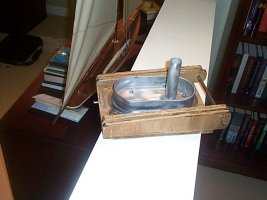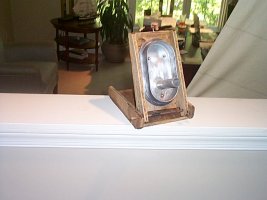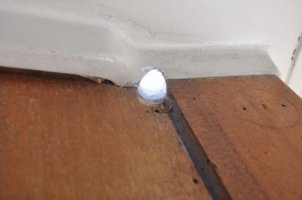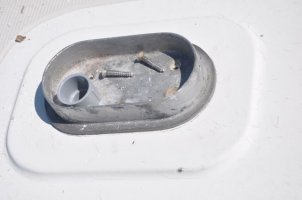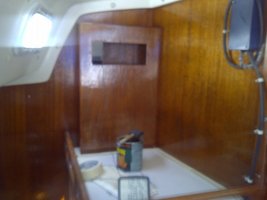Starting an archaeological dig into the mast step and would appreciate any advice from previous explorers. We've got a few days dry weather forecast, so I'm starting in on the deck hardware and sanding. The problem at hand is the mast step and routing wires to the mast. (I've just finished re-wiring the whole boat. Except for this.) The only existing electrical device up the mast is the steaming light which doesn't work. There was a wire for some kind of wind instrument, but it's long gone.
The previous wiring, which otherwise looks to be original, is four wires that ran up the side of the compression post, behind a piece of trim, and disappeared into the liner. When the mast came off, it could be seen that they were routed through one of the mounting holes for the aluminum step, which someone had hogged out with a drill. Wow, that doesn't look very "professional." No drip protection either. No sign of any previous wires though. My guess is that this detail was not found on the blueprints, so the yard guys sort of winged it. I COULD re-use these four wires to get steaming, anchor, and spreader lights with a common ground (all LEDs). But I still need a larger opening for antenna wire. And there are other toys to consider, like the hailer and the GPS antenna.
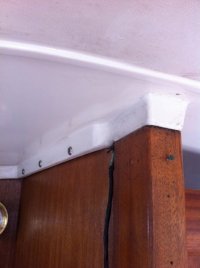
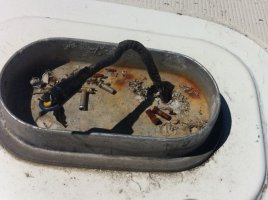
Under the step, we find two more holes, that were full of putty. At the bottom are two bronze screw heads, which I imagine bind the deck to the compression post. No sign of any other previous wiring channel. My first idea is to drill a new hole about where the pointer is there. If those bronze screws mark the center of the compression post, this ought to clear it. (If so, this means that the mast is offset slightly from the post.) After an exploratory hole, I think I'd drill a 3/4 or 1" hole all the way through the shoe, deck, and liner, and install a PVC fitting to act as a conduit and a dam in case of water intrusion. If my assumptions are wrong, it could make a heck of a mess.

So if all of the above is correct, the new hole would come out just starboard of the compression post, above the passage way. Depending on where the hole lands, I'd fasten an electrical junction box either to the overhead liner or the side of the post, with a foam backing to fill the irregular surfaces behind. It's more of an obtrusive location than I had imagined. Then I'd have to figure out how to run conduit down and through the bulkhead without interfering with the door, drilling through a structural member, or looking excessively ugly.

As an alternative, I could just enlarge the hogged-out hole that was previously used. The mast has been riding on three screws all of these years anyway... I'm guessing that would cut a notch into the top of the bulkhead and the liner, just forward of the old wires. I'm a bit worried that the drill might cut a corner off of the compression post though. I can't really see what's happening behind the liner. Anyway, the junction box would be less obtrusive in this location, and conduit could just run straight down into the chart table. Or I could enclose it with a mahogany trim piece, sort of as before.
I guess I'll ponder the potentially ugly alternatives for a day or two and hope that someone here has gone there before. Plenty of other bits to work on today.
The previous wiring, which otherwise looks to be original, is four wires that ran up the side of the compression post, behind a piece of trim, and disappeared into the liner. When the mast came off, it could be seen that they were routed through one of the mounting holes for the aluminum step, which someone had hogged out with a drill. Wow, that doesn't look very "professional." No drip protection either. No sign of any previous wires though. My guess is that this detail was not found on the blueprints, so the yard guys sort of winged it. I COULD re-use these four wires to get steaming, anchor, and spreader lights with a common ground (all LEDs). But I still need a larger opening for antenna wire. And there are other toys to consider, like the hailer and the GPS antenna.


Under the step, we find two more holes, that were full of putty. At the bottom are two bronze screw heads, which I imagine bind the deck to the compression post. No sign of any other previous wiring channel. My first idea is to drill a new hole about where the pointer is there. If those bronze screws mark the center of the compression post, this ought to clear it. (If so, this means that the mast is offset slightly from the post.) After an exploratory hole, I think I'd drill a 3/4 or 1" hole all the way through the shoe, deck, and liner, and install a PVC fitting to act as a conduit and a dam in case of water intrusion. If my assumptions are wrong, it could make a heck of a mess.

So if all of the above is correct, the new hole would come out just starboard of the compression post, above the passage way. Depending on where the hole lands, I'd fasten an electrical junction box either to the overhead liner or the side of the post, with a foam backing to fill the irregular surfaces behind. It's more of an obtrusive location than I had imagined. Then I'd have to figure out how to run conduit down and through the bulkhead without interfering with the door, drilling through a structural member, or looking excessively ugly.

As an alternative, I could just enlarge the hogged-out hole that was previously used. The mast has been riding on three screws all of these years anyway... I'm guessing that would cut a notch into the top of the bulkhead and the liner, just forward of the old wires. I'm a bit worried that the drill might cut a corner off of the compression post though. I can't really see what's happening behind the liner. Anyway, the junction box would be less obtrusive in this location, and conduit could just run straight down into the chart table. Or I could enclose it with a mahogany trim piece, sort of as before.
I guess I'll ponder the potentially ugly alternatives for a day or two and hope that someone here has gone there before. Plenty of other bits to work on today.

